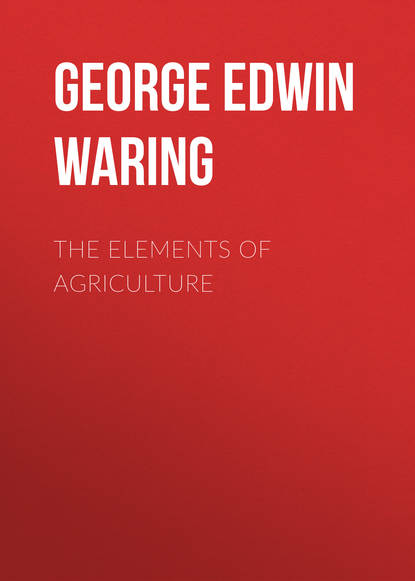По всем вопросам обращайтесь на: info@litportal.ru
(©) 2003-2024.
✖
The Elements of Agriculture
Настройки чтения
Размер шрифта
Высота строк
Поля
When rains are allowed to enter the soil, how do they benefit it?
How do under-drains prevent the formation of a crust on the surface of a soil?
18. When not saturated with water the soil admits the water of rains, etc., which bring with them fertilizing gases from the atmosphere, to be deposited among the absorbent parts of soil, and given up to the necessities of the plant. When this rain falls on lands already saturated, it cannot enter the soil, but must run off from the surface, or be removed by evaporation, either of which is injurious. The first, because fertilizing matter is washed away. The second, because the soil is deprived of necessary heat.
19. The formation of crust on the surface of the soil is due to the evaporation of water, which is drawn up from below by capillary attraction. It arises from the fact that the water in the soil is saturated with mineral substances, which it leaves at its point of evaporation at the surface. This soluble matter from below, often forms a very hard crust, which is a complete shield to prevent the admission of air with its ameliorating effects, and should, as far as possible, be avoided. Under-draining is the best means of doing this, as it is the best means of lessening the evaporation.
The foregoing are some of the more important reasons why under-draining is always beneficial. Thorough experiments have amply proved the truth of the theory.
What kinds of soil are benefited by under-draining?
The kinds of soil benefited by under-draining are nearly as unlimited as the kinds of soil in existence. It is a common opinion, among farmers, that the only soils which require draining are those which are at times covered with water, such as swamps and other low lands; but the facts stated in the early part of this chapter, show us that every kind of soil—wet, dry, compact, or light—receives benefit from the treatment. The fact that land is too dry, is as much a reason why it should be drained, as that it is too wet, as it overcomes drought as effectually as it removes the injurious effects of too much water.
All soils in which the water of heavy rains does not immediately pass down to a depth of at least thirty inches, should be under-drained, and the operation, if carried on with judgment, would invariably result in profit.
What do English farmers name as the profits of under-draining?
What stand has been taken by the English government with regard to under-draining?
Of the precise profits of under-draining this is not the place to speak: many of the agricultural papers contain numerous accounts of its success. It may be well to remark here, that many English farmers give it, as their experience, that under-drains pay for themselves every three years, or that they produce a perpetual profit of 33⅓ per cent., or their original cost. This is not the opinion of theorists and book farmers. It is the conviction of practical men, who know, from experience, that under-drains are beneficial.
The best evidence of the utility of under-draining is the position, with regard to it, which has been taken by the English national government, which affords much protection to the agricultural interests of her people—a protection which in this country is unwisely and unjustly withheld.
In England a very large sum from the public treasury has been appropriated as a fund for loans, on under-drains, which is lent to farmers for the purpose of under-draining their estates, the only security given being the increased value of the soil. The time allowed for payments is twenty years, and only five per cent. interest is charged. By the influence of this patronage, the actual wealth of the kingdom is being rapidly increased, while the farmers themselves, can raise their farms to any desired state of fertility, without immediate investment.
How does under-draining affect the healthfulness of marshy countries?
Describe the sub-soil plow.
The best proof that the government has not acted injudiciously in this matter is, that private capitalists are fast employing their money in the same manner, and loans on under-drains are considered a very safe investment.
There is no doubt that we may soon have similar facilities for improving our farms, and when we do, we shall find that it is unnecessary to move West to find good soil. The districts nearer market, where the expense of transportation is much less, may, by the aid of under-drains, and a judicious system of cultivation, be made equally fertile.
One very important, though not strictly agricultural, effect of thorough drainage is its removal of certain local diseases, peculiar to the vicinity of marshy or low moist soils. The health-reports in several places in England, show that where fever and ague was once common, it has almost entirely disappeared since the general use of under-drains in those localities.
CHAPTER IV
SUB-SOIL PLOWING
Describe the Mapes plow.
Why is the motion in the soil of one and a half inches sufficient?
How does the oxidation of the particles of the soil resemble the rusting of cannon balls in a pile?
The sub-soil plow is an implement differing in figure from the surface plow. It does not turn a furrow, but merely runs through the subsoil like a mole—loosening and making it finer by lifting, but allowing it to fall back and occupy its former place. It usually follows the surface plow, entering the soil to the depth of from twelve to eighteen inches below the bottom of the surface furrow.
The best pattern now made (the Mapes plow) is represented in the following figure.
Fig. 8.
The Mapes plow and its mode of action. a—Shape of the foot of the plow, b—Its effect on the soil.
The sub-soil plows first made raised the whole soil about eight inches, and required very great power in their use often six, eight, or even ten oxen. The Mapes plow, raising the soil but slightly, may be worked with much less power, and produces equally good results. It may be run to its full depth in most soils by a single yoke of oxen.
Of course a motion in the soil of but one and a half inches is very slight, but it is sufficient to move each particle from the one next to it which, in dry soils, is all that is necessary. Whoever has examined a pile of cannon-balls must have observed that at the points where they touch each other, there is a little rust. In the soil, the same is often the case. Where the particles touch each other, there is such a chemical change produced as renders them fit for the use of plants. While these particles remain in their first position, the changed portions are out of the reach of roots; but, if, by the aid of the sub-soil plow, their position is altered, these parts are exposed for the uses of plants. If we hold in the hand a ball of dry clay, and press it hard enough to produce the least motion among its particles, the whole mass becomes pulverized. On the same principle, the sub-soil plow renders the compact lower soil sufficiently fine for the requirements of fertility.
Why are the benefits of sub-soiling not permanent on wet lands?
Does sub-soiling overcome drought?
How does it deepen the surface soil?
Notwithstanding its great benefits on land, which is sufficiently dry, sub-soiling cannot be recommended for wet lands; for, in such case, the rains of a single season would often be sufficient to entirely overcome its effects by packing the subsoil down to its former hardness.
On lands not overcharged with water, it is productive of the best results, it being often sufficient to turn the balance between a gaining and a losing business in farming.
It increases nearly every effect of under-draining; especially does it overcome drought, by loosening the soil, and admitting air to circulate among the particles of the subsoil and deposit its moisture on the principle described in the chapter on under-draining.
It deepens the surface-soil, because it admits roots into the subsoil where they decay and leave carbon, while the circulation of air so affects the mineral parts, that they become of a fertilizing character. The deposit of carbon gives to the subsoil the power of absorbing, and retaining the atmospheric fertilizers, which are more freely presented, owing to the fact that the air is allowed to circulate with greater freedom. As a majority of roots decay in the surface-soil, they there deposit much mineral matter obtained from the subsoil.
Why is the retention of atmospheric manures ensured by sub-soiling?
Why are organic manures plowed deeply under the soil, less liable to evaporation than when deposited near the surface?
How does sub-soiling resemble under-draining in relation to the tillering of grasses?
When the subsoil consists of a thin layer of clay on a sandy bed, what use may be made of the sub-soil plow?
The retention of atmospheric manures is more fully ensured by the better exposure of the clayey portions of the soil.
Those manures which are artificially applied, by being plowed under to greater depths, are less liable to evaporation, as, from the greater amount of soil above them, their escape will more probably be arrested; and, from the greater prevalence of roots, they are more liable to be taken up by plants.
The subsoil often contains matters which are deficient in the surface-soil. By the use of the sub-soil plow, they are rendered available.
Sub-soiling is similar to under-draining in continuing the tillering of grasses, and in getting rid of the poisonous excrementitious matter of plants.
When the subsoil is a thin layer of clay on a sandy bed (as in some plants of Cumberland Co. Maine), the sub-soil plow, by passing through it, opens a passage for water, and often affords a sufficient drainage.
To how great a depth will the roots of plants usually occupy the soil?
What is the object of loosening the soil?
How are these various effects better produced in deep than in shallow soils?
If plants will grow better on a soil six inches deep than on one of three inches, there is no reason why they should not be benefited in proportion, by disturbing the soil to the whole depth to which roots will travel—which is usually more than two feet. The minute rootlets of corn and most other plants, will, if allowed by cultivation, occupy the soil to the depth or thirty-four inches, having a fibre in nearly every cubic inch of the soil for the whole distance. There are very few cultivated plants whose roots would not travel to a depth of thirty inches or more. Even the onion sends its roots to the depth of eighteen inches when the soil is well cultivated.
The object of loosening the soil is to admit roots to a sufficient depth to hold the plant in its position—to obtain the nutriment necessary to its growth—to receive moisture from the lower portions of the soil—and, if it be a bulb, tuber, or tap, to assume the form requisite for its largest development.






